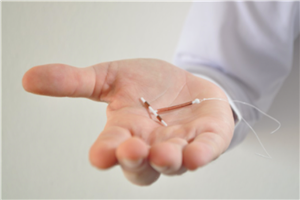IT’S enough to make a woman wince, imagining having the coil removed.
An expert has revealed exactly what happens using a model in the hope of giving women reassurance.
Women with the device may fear having it taken out, given that it is inserted into the womb – an often painful experience.
But certified nurse-midwife Sarah Pringle’s demonstration video shows it should slide out with ease, after tugging on the string that it is attached to.
Sarah's TikTok and Instagram pages are full of educational videos which cover everything from pregnancy to periods and contraception.
The coil, medically called an intrauterine device (IUD) or intrauterine system (IUS), is inserted through the vagina, cervix, and into the womb where it stays.
It’s a small T-shaped device no wider than your palm that takes up the space of the womb, where a baby would grow during pregnancy.
An IUD can be left in the womb for five to ten years, depending on the type, giving women a long-lasting birth control method that doesn't involve hormones or remembering a daily pill.
Most read in Health
HIGH ALERT Warning over fatal Covid complication that strikes MONTHS after bug
The 5 simple changes that could add ten YEARS to your life
UK's new daily Covid cases plummet by 40% in a week as deaths rise to 314
The sleeping position that slashes your risk of developing Alzheimer's
An IUD releases copper, while the IUS releases the hormone progesterone, in order to ward off pregnancy.
An IUD has twp thin threads that hang down a little way from your womb into the top of the vagina.
These threads cannot be seen from the vulva – the opening to the vagina.
And a partner should not be able to feel these threads during sex.
The NHS says: “Your IUD can be removed at any time by a trained doctor or nurse.”
Sarah penned over a video posted to TikTok: “Using a special tool, your provider will gently pull on the strings and pull out the IUD.
“Its arms will fold up as it slides out.”
She uses a petri-dish containing a silicone model of a womb to show how the device fits in, and is taken out of, the womb.
Sarah was replying to a comment that asked for the demonstration of an IUD removal and what to expect, because her “anxiety is HIGH from the insertion”.
Having the coil fitted and removed can be an agonising experience, and medics don’t always offer pain relief.
The Faculty of Sexual and Reproductive Healthcare (FSRH) says that for many women, the pain of a coil insertion is similar to period cramps.
The FSRH, part of the Royal College of Obstetricians and Gynaecologists, said in July 2021 that “women should always be offered pain relief in IUD procedures” after hearing testimonials.
And if it is not available, they should be referred somewhere else.
It came after a petition, started by Lucy Cohen and calling for “better pain relief” during coil procedures, was signed by almost 35,000 people.
Lucy said she believes women should be given the option of gas and air, sedation or muscle relaxants.
As well as this, “better expectation management of what the insertion and removal of an IUD entails” because “without fully explaining the real potential pain, how can consent truly be given?”.
Source: Read Full Article





